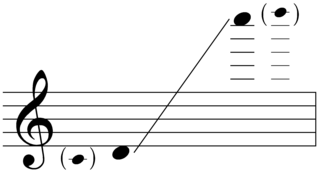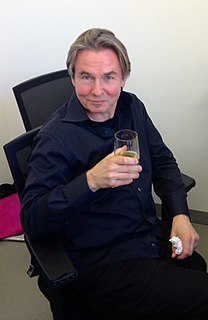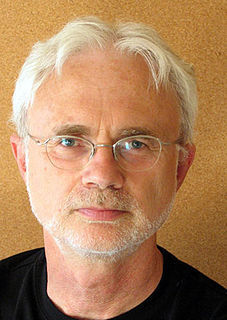Instrumentation
The work is scored for 4 flutes (3, 4 double piccolos), 3 oboes (3 doubles English horn), 3 Bb clarinets (3 doubles bass clarinet 2), bass clarinet, 3 bassoons (3 doubles contrabassoon), 4 horns in F, 4 trumpets, 3 trombones, 2 tubas, amplified steel string guitar, piano, celesta, keyboard sampler, 2 harps, 5 percussion (including 3 who are principally mallet players), and strings. [1]

The Western concert flute is a transverse (side-blown) woodwind instrument made of metal or wood. It is the most common variant of the flute. A musician who plays the flute is called a flautist, flutist, flute player, or (rarely) fluter.

The piccolo is a half-size flute, and a member of the woodwind family of musical instruments. The modern piccolo has most of the same fingerings as its larger sibling, the standard transverse flute, but the sound it produces is an octave higher than written. This gave rise to the name ottavino, which the instrument is called in the scores of Italian composers. It is also called flauto piccolo or flautino.

Oboes belong to the classification of double reed woodwind instruments. Oboes are usually made of wood, but there are also oboes made of synthetic materials. The most common oboe plays in the treble or soprano range. A soprano oboe measures roughly 65 cm long, with metal keys, a conical bore and a flared bell. Sound is produced by blowing into the reed at a sufficient air pressure, causing it to vibrate with the air column. The distinctive tone is versatile and has been described as "bright". When the word oboe is used alone, it is generally taken to mean the treble instrument rather than other instruments of the family, such as the bass oboe, the cor anglais, or oboe d'amore
Critical reception
In his review of the world premiere, Mark Swed, music critic for the L.A. Times, praised the work for its grand reach, stating that while stylistically it resembled Adams’s earlier works, "Everything is bigger and better". [3] For the New York Premiere, Bernard Holland, music critic for the N.Y. Times, found the piece "Unlovely, yet compelling" in its multiple layers of sound and rhythm. [4] Five years later, in its local premiere with the San Francisco Symphony, Joshua Kosman, music critic for the S.F. Chronicle, praised the work in its scope and composition, writing that it "takes its rhetoric and sense of scale from the symphonies of Bruckner, Mahler and Sibelius, and its musical content from the nexus of pop melody and old-style minimalism a la Steve Reich". [5] It was nominated for a Grammy Award in 2003 for "Best classical contemporary composition". [1]

A Grammy Award, or Grammy, is an award presented by The Recording Academy to recognize achievements in the music industry. The annual presentation ceremony features performances by prominent artists, and the presentation of those awards that have a more popular interest. The Grammys are the second of the Big Three major music awards held annually.
The Los Angeles Philharmonic is an American orchestra based in Los Angeles, California. It has a regular season of concerts from October through June at the Walt Disney Concert Hall, and a summer season at the Hollywood Bowl from July through September. Gustavo Dudamel is the Music Director, Esa-Pekka Salonen is Conductor Laureate, and Zubin Mehta is Conductor Emeritus.

Esa-Pekka Salonen is a Finnish orchestral conductor and composer. He is principal conductor and artistic advisor of the Philharmonia Orchestra in London, conductor laureate of the Los Angeles Philharmonic, and music director-designate of the San Francisco Symphony.
City Noir is a symphonic work by the composer John Adams. A primary inspiration for the piece is the work of historian Kevin Starr on urban California in the late 1940s and early 1950s. The composer characterizes the work as "jazz-inflected symphonic music", citing the French composer Darius Milhaud as originator of this trend. It has a duration of 35 minutes, features solos for alto saxophone, trumpet, trombone, horn, viola, and double bass, and has three movements:
- The City and its Double
- The Song is for You
- Boulevard Night
Symphony No. 9 is Philip Glass's ninth symphony. It was written between 2010 and 2011. It is written in 3 movements. The work was jointly commissioned by the Bruckner Orchester Linz, Carnegie Hall, and the Los Angeles Philharmonic Association.
My Father Knew Charles Ives is an orchestral triptych by the American composer John Adams. The work was commissioned by the San Francisco Symphony. It was first performed by the San Francisco Symphony under the direction of Michael Tilson Thomas at the Louise M. Davies Symphony Hall on April 30, 2003.
Symphony No. 1 is a symphony in one movement by the American composer Christopher Rouse. The work was commissioned by David Zinman and the Baltimore Symphony Orchestra, completed August 26, 1986, and premiered in Baltimore, January 21, 1988. The piece is dedicated to Rouse's friend and fellow composer John Harbison.
The Second Concerto for Orchestra is a concerto for orchestra by the American composer Steven Stucky. The work was commissioned by the Los Angeles Philharmonic while Stucky was their composer-in-residence for the inaugural season of the Walt Disney Concert Hall. It was completed in 2003 and was first performed on March 12, 2004, with the conductor Esa-Pekka Salonen leading the Los Angeles Philharmonic. The piece was awarded the 2005 Pulitzer Prize for Music.
Radical Light is a single-movement orchestral composition by the American composer Steven Stucky. The work was commissioned by the Los Angeles Philharmonic with contributions from Lenore and Bernard Greenberg. It was premiered October 18, 2007 at the Walt Disney Concert Hall in Los Angeles, with conductor Esa-Pekka Salonen leading the Los Angeles Philharmonic. The title of the piece comes from the poem "He Held Radical Light" by A. R. Ammons.
The Piano Concerto is a concerto for solo piano and orchestra in three movements by the Finnish composer Esa-Pekka Salonen. The work was jointly commissioned by the New York Philharmonic, the BBC, the NDR Symphony Orchestra, and Radio France. It was premiered February 1, 2007 in Avery Fisher Hall, New York City, with Salonen conducting the pianist Yefim Bronfman and the New York Philharmonic. Salonen dedicated the piece to Yefim Bronfman.
Nyx is a symphonic poem by the Finnish composer Esa-Pekka Salonen. The work was jointly commissioned by Radio France, the Barbican Centre, the Atlanta Symphony Orchestra, Carnegie Hall, and the Finnish Broadcasting Company. It was premiered February 19, 2011 in the Théâtre du Châtelet, Paris, with Salonen conducting the Orchestre Philharmonique de Radio France. The piece is titled after the Goddess Nyx from Greek mythology.
L.A. Variations is an orchestral composition by the Finnish composer Esa-Pekka Salonen. The work was commissioned by the Los Angeles Philharmonic, of which Salonen was then music director. It was first performed at the Dorothy Chandler Pavilion in Los Angeles, January 16, 1997, with Salonen conducting the Los Angeles Philharmonic. The piece is dedicated to the orchestra, about which Salonen remarked, "I wrote LA Variations specifically for the players of the Los Angeles Philharmonic. I'm very proud of the virtuosity and power of my orchestra."
Wing on Wing is a single-movement composition for two sopranos and orchestra by the Finnish composer Esa-Pekka Salonen. The work was commissioned by the Los Angeles Philharmonic for their inaugural season at the Walt Disney Concert Hall and was premiered June 5, 2004 by the orchestra under Salonen. The piece is dedicated to the architect Frank Gehry, the acoustician Yasuhisa Toyota, and the L.A. Philharmonic CEO Deborah Borda.
Foreign Bodies is an orchestral composition in three movements by the Finnish composer Esa-Pekka Salonen. The work was commissioned by the Finnish Broadcasting Company and was first performed at the Schleswig-Holstein Musik Festival on August 12, 2001 by the Finnish Radio Symphony Orchestra under the conductor Jukka-Pekka Saraste.
Insomnia is a single-movement orchestral composition by the Finnish composer Esa-Pekka Salonen. The work was composed between March and November 2002 and was first performed on December 1, 2002 by the NHK Symphony Orchestra under Salonen.
Polaris: Voyage for Orchestra is an orchestral composition by the British composer Thomas Adès. The work was co-commissioned by the New World Symphony under the direction of Michael Tilson Thomas for the opening of the New World Center. The New World Symphony was joined in commission by the Royal Concertgebouw Orchestra, the New York Philharmonic, the Calouste Gulbenkian Foundation, the Barbican Centre, the Los Angeles Philharmonic, and the San Francisco Symphony. It was given its world premiere by Michael Tilson Thomas and the New World Symphony at the New World Center in Miami Beach on January 26, 2011.
Fresco is an orchestral composition by the Finnish composer Magnus Lindberg. The work was commissioned by the Los Angeles Philharmonic. Its world premiere was given in Los Angeles on March 12, 1998 by the Los Angeles Philharmonic under the direction of Esa-Pekka Salonen, to whom the piece is dedicated.
Absolute Jest is a concerto for string quartet and orchestra by the American composer John Adams. The work was commissioned by the San Francisco Symphony for the orchestra's centennial. Its world premiere was given at the Louise M. Davies Symphony Hall on March 15, 2012, and was performed by the St. Lawrence String Quartet and the San Francisco Symphony under the direction of Michael Tilson Thomas. However, after the premiere Adams heavily re-wrote the beginning of the piece; this revised version of Absolute Jest was first performed in Miami Beach on December 1, 2012, by the St. Lawrence String Quartet and the New World Symphony under the composer's direction.
Sculpture is an orchestral composition by the Finnish composer Magnus Lindberg. The music was commissioned by the Los Angeles Philharmonic with support from the Koussevitzky Music Foundation to celebrate the orchestra's inaugural season at the Walt Disney Concert Hall. Its world premiere was given by the Los Angeles Philharmonic under the direction of Esa-Pekka Salonen on October 6, 2005.
Parada is an orchestral composition by the Finnish composer Magnus Lindberg. The piece was composed for the music festival Related Rocks which celebrates the works of Lindberg and related composers. Its world premiere was given at The Anvil, Basingstoke on February 6, 2002 by the Philharmonia Orchestra under the direction of Esa-Pekka Salonen, to whom the work is dedicated.
Karawane is a composition for chorus and orchestra by the Finnish composer Esa-Pekka Salonen. The work was jointly commissioned by the Tonhalle Orchester Zürich, the Swedish Radio Symphony Orchestra, the New York Philharmonic with support from the philanthropist Marie-Josée Kravis, the Bamberg Symphony, and the Finnish Radio Symphony Orchestra. It was first performed by the Tonhalle Orchester Zürich and the Zürcher Sing-Akademie conducted by Lionel Bringuier in the Tonhalle, Zürich, on September 10, 2014. The piece is set to the eponymous poem by the German author and Dadaist Hugo Ball.








